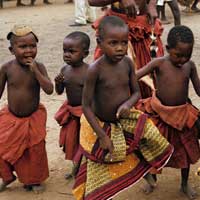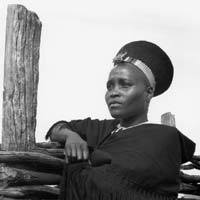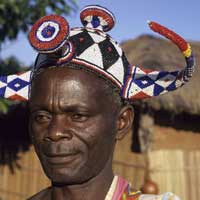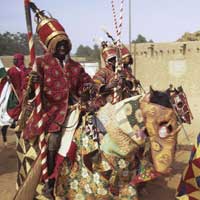

Fig. 5
Kuba children dancing during royal visit

Fig. 6
Zulu woman

Fig. 7
Kwilu Pende chief wearing beaded hat

Fig. 8
Hausa armed horsemen in quilted armor at Independence Day celebration

Fig. 9
Master hunters Siaka Dembélé and Kadiene N'golo Dembélé
Province of Kénédougou, southwestern Burkina Faso
Gender, age and accomplishment are reinforced
From an early age, African children receive verbal and visual instruction in their society's moral and cultural values. Children's traditional necklaces, waistbeads and loin coverings, for example, provide visual cues to differentiate gender and to reinforce societal norms about modesty and decorum that guide boys and girls from their youth onwards (fig. 5). While some traditional forms of apparel may continue to varying degrees up to the present, nowadays they are combined with store-bought and hand-tailored outfits, school uniforms and popular clothing fads that tend to define the dress of young people the world over.
During adolescence and into adulthood, specific forms of attire reinforce gender distinctions and mark particular accomplishments and changes in social status that men and women achieve through initiation, marriage or membership into specialized associations. In Africa, headwear is a particularly rich format for conveying such information, drawing attention to the head as an important carrier of cultural messages. The married status of a Zulu woman, for example, was traditionally signaled through her distinctive flared or columnar red-colored hat (fig. 6). The visually striking beaded hat of a Pende or Yaka chief (see fig. 7) marks his position as a traditional ruler, and its form—suggesting buffalo horns—alludes to the strength and power required of a traditional ruler.
Materials communicate the message
In fashioning clothing and accessories, African artists employ inventive combinations of particular, deliberately selected materials to achieve the aesthetic and communicative goals of those destined to wear their creations. Precious glass beads, ivory, shell and brass may convey positions of leadership or communicate high status and economic prominence, as these materials were often associated with traditional rulers and were long valued as lucrative trade goods in much of Africa (fig. 7). Imported fabrics, buttons, sequins, metallic threads and so on may announce one's affluence, one's capacity for change or innovation, or simply one's desire to impress others with the new or the unusual.
The acquisition of specialized knowledge and its link to authority and power is communicated in many ways, including particular forms of attire. In Africa, for example, men's tunics, shirts and hats may be decorated with the teeth, horn, quills or skin of wild animals or the feathers, beaks or claws of birds of prey. These materials, along with natural fibers and earthen pigments, often announce men's roles as traditional hunters, healers and leaders and recognize their training and abilities to control and use the potentially dangerous forces of the wilderness. Traditional warrior garb may also be similarly embellished, but more practical solutions such as chain mail and padded tunics also offer protection and acknowledge the dangerous conditions of warfare and the courage required to confront them (fig. 8).
At times, the forms and materials of African dress reinforce the importance of literacy in written, graphic and mnemonic systems that confer power and authority on those proficient in these specialized styles of communication. Culturally specific meaning encoded in the colors, patterns and motifs of certain attire allow these objects to be "read" by those trained in particular visual systems. The traditional beaded clothing of Ndebele women, for example, indicates fluency in beadwork patterns that communicate age and status (see fig. 4). Clothing in Nigeria decorated with elaborate arabesque embroidery and hunters and healers shirts from West Africa ornamented with leather amulets containing written inscriptions from the Qur'an reflect literacy in Arabic and the power of the Word of God to protect and inspire (fig. 9).
Back to: NMAfA exhibits